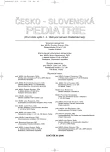-
Medical journals
- Career
Ten Years of Experience with Drug Therapy of Familial Hypercholesterolemia in Children and Adolescents
Authors: J. Hyánek; V. Martiníková; V. Maťoška; J. Dvořáková; H. Přindišová; J. Dudková; L. Dubská; M. Loučka; H. Jenčová; M. Vodičková
Authors‘ workplace: Institut matematiky a statistiky VŠCHT, Praha přednosta doc. Ing. M. Loučka, CSc. ; Radiodiagnostické oddělení, Nemocnice Na Homolce, Praha primářka MUDr. J. Janoušková, CSc. ; Oddělení nukleární medicíny, Nemocnice Na Homolce, Praha přednosta doc. MUDr. O. Bělohlávek, CSc. ; Oddělení klinické biochemie, hematologie a imunologie, Nemocnice Na Homolce, Praha primář MUDr. M. Průcha, PhD.
Published in: Čes-slov Pediat 2006; 61 (7-8): 404-412.
Category: Original Papers
Overview
The therapeutic effect of administration of simvastatin on the decrease of total cholesterol in plasma was evaluated in 33 children suffering from heterozygous form of hypercholesterolemia at the age of 10–18 years and living in the Prague agglomeration. The somatic and sexual development was observed, side effects were evaluated clinically and by laboratory methods. Simvastatin proved to be well tolerated in all children (in contrast to low-cholesterol diet or ion-exchange resin therapy applied before). The therapeutic effect of simvastatin was compared with the effects of low-cholesterol diet and the ion-exchange resin therapy in a control group of children and adolescents of the same age. The therapy started with the therapeutic dose of 2.5–5 mg/d in the youngest children, in the older children and adolescents the authors used 10–20 mg/d. The shortest period of time of administration was one year, while the longest period was 11 years. As early as after one month there was a marked decrease of total cholesterol, LDL-cholesterol, lipoprotein Apo-B on the average by 39%; the increase of HDL cholesterol or lipoprotein Apo-A1 was marginal – up to 5% and the changes in triglycerides were not significant. There were not any untoward effects and the sexual and hormonal development was not influenced. The originally increased levels of total bilirubin were explained in the course of the study by the presence of heterozygous or homozygous mutation for the Gilbert disease. Examples of monitoring of typical patients are presented.
Key words:
familial hypercholesterolemia, children, adolescents, drug treatment
Labels
Neonatology Paediatrics General practitioner for children and adolescents
Article was published inCzech-Slovak Pediatrics

2006 Issue 7-8-
All articles in this issue
- Ten Years of Experience with Drug Therapy of Familial Hypercholesterolemia in Children and Adolescents
- The Therapy of the Deep Cartilage Defects in the Knee Joint by the Transplantation of Cultivated Autologous Chondrocytes in Children and Adolescents
- Late Diagnostics and Therapy of Pyloric Membrane
- Alobar Holoprosencephaly – A Case Report of Two Cases
- Indication and Principles of Molecular-Genetic Investigation
- Present Knowledge about Bird Influenza and Importance for Human Population
- Cardiopulmonary Resuscitation – Novel Recommended Procedures
- Czech-Slovak Pediatrics
- Journal archive
- Current issue
- Online only
- About the journal
Most read in this issue- Alobar Holoprosencephaly – A Case Report of Two Cases
- Indication and Principles of Molecular-Genetic Investigation
- The Therapy of the Deep Cartilage Defects in the Knee Joint by the Transplantation of Cultivated Autologous Chondrocytes in Children and Adolescents
- Cardiopulmonary Resuscitation – Novel Recommended Procedures
Login#ADS_BOTTOM_SCRIPTS#Forgotten passwordEnter the email address that you registered with. We will send you instructions on how to set a new password.
- Career

